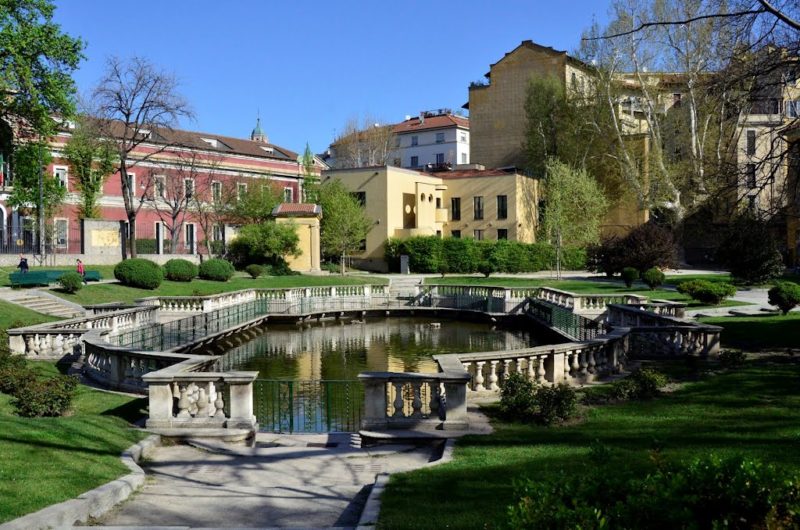
Guastalla Gardens
This post is also available in:
 Italiano (Italian)
Italiano (Italian)
Guastalla Gardens are in Milan, overlooking Via Francesco Sforza, opposite of the State University and alongside Maggiore Hospital.
Despite the limited size (30 acres), these are the oldest public gardens in Milan, accessible through three different entrances: the main one on via Francesco Sforza, and the two side access on via Sa Barnaba and on via Guastalla.
These gardens were built by the Countess Paola Ludovica Torelli, Countess of Guastalla, to surround her abode for former nobles in the charitable foundation of “Collegio della Guastalla”. The construction works were completed in 1555. The typical Italian gardens include a baroque fishpond with a marble balustrade, and pink “Baveno” granite steps, stone sculptures, a neo-classic temple by Luigi Cagnola (next to the entrance gate on via Francesco Sforza), and, on the other side of the staircase, a XVII century aedicule with the statue of Mary Magdalene and some angels ( made with polychrome terracotta in need of restoration).
Some centuries-old trees grow around the water, including beeches, black walnuts, magnolias, horse-chestnuts, a catalpa, and several others.
Along the external boundary wall, on the corner between via Guastalla and via San Barnaba, there is an elegant fountain with a lion’s head and some jets of water (not always working).
In 1938, the Municipality of Milan bought the whole area and entrusted with the restoration project the architect Renzo Gerla. Engineer Gaetano Fassi, on the other hand, was asked to take care of the botanical aspects, including the decoration of the area around the fish pond with rose bushes and round-shaped boxwood.
Due to other following building projects, the strip of green connecting Guastalla Gardens to Sormani Park was canceled.
Today, these gardens feature a dog playground and children’s recreational facilities.
Among the main plant species, there are silver maples (Acer saccharinum), tulip trees (Liriodendron tulipifera), trifoliate orange trees (Citrus trifoliata), Atlas cedars (Cedrus atlantica), beeches (Fagus sylvatica “Pendula”), oaks (Quercus robur), red horse-chestnut (Aesculus x carnea), sweetgums (Liquidambar styraciflua), and small-leaved limes (Tilia cordata).
It’s also worth mentioning the catalpa with its twisted, monumental trunk and asymmetric canopy – it looks like a natural sculpture – and a group of European beeches (Fagus sylvatica “Asplenifolia”) offering their shade to the children’s playground near the entrance on via Guastalla.
Shrubs include silverberry (Eleagnus spp.), Japanese cheesewood (Pittosporum tobira), cotoneaster (Cotoneaster), sacred bamboo (Nandina spp.), aucuba (Aucuba japonica), and Oregon grape (Mahonia aquifolium).
Photo source:
http://www.propertieslife.it/web/news.asp?id=991&title=alla_scoperta_del_giardino_della_guastalla_&language=ita
This post is also available in:
 Italiano (Italian)
Italiano (Italian)
Contatti
Via Francesco Sforza - 20122 Milano (MI)
+39 02 0202
https://www.comune.milano.it/aree-tematiche/verde/parchi/giardino-della-guastalla
Altre info
tutto l'anno, tutti i giorni
Da aprile a fine settmbre, dalle 7 alle 22. In ottobre, dalle 7alle 21. Da novembre a marzo, 7 alle 19.
